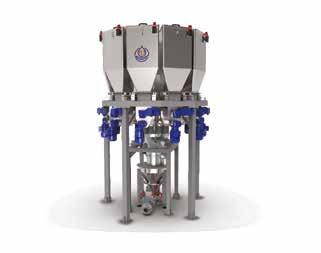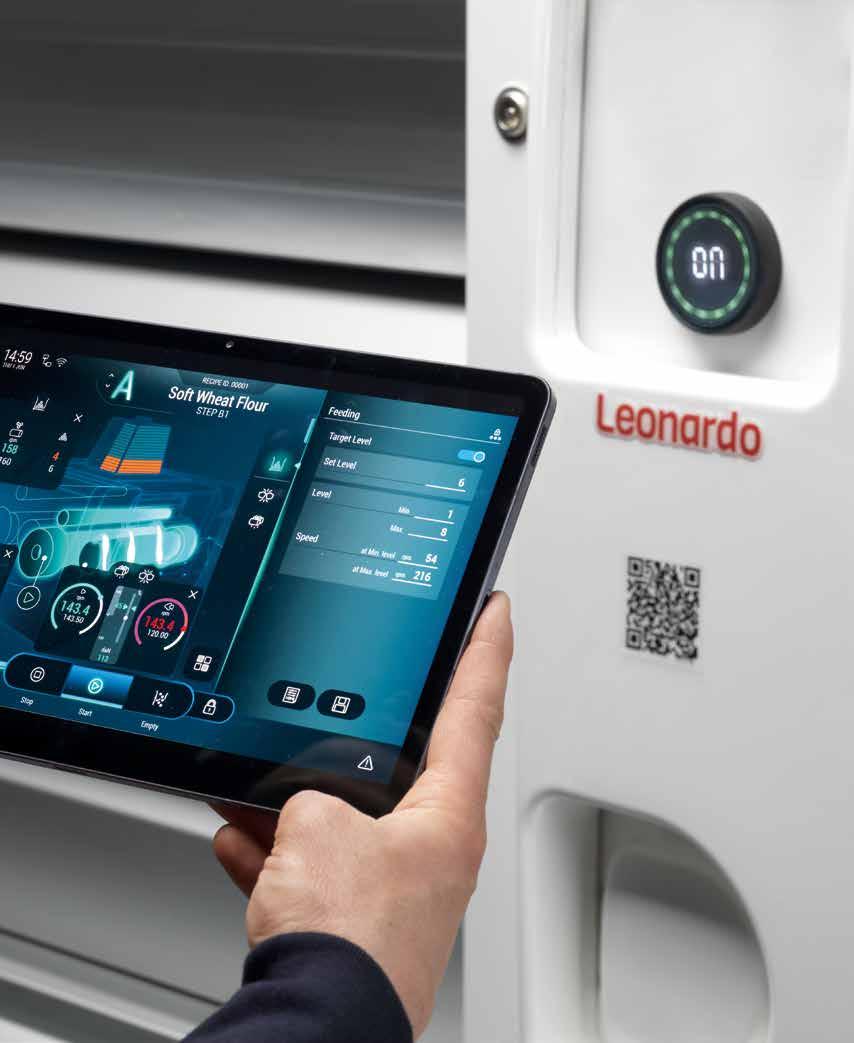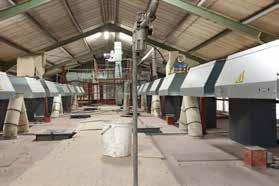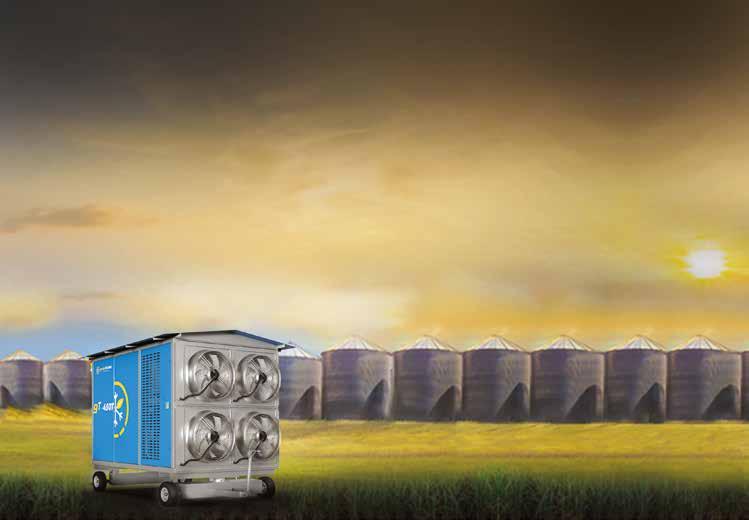
8 minute read
Commodity handling equipment: Why understanding what the right
Skandia belt and bucket elevator in situ within a milling operation
COMMODITY HANDLING EQUIPMENT
Advertisement
Why understanding what the right configuration for your operation is key
by Andrew Head, Sales Director, BDC Systems Ltd, UK
ith increased uncertainty
Waround energy costs, both commercial grain operators, millers and farmers alike are struggling to make accurate forecasts as to exactly what they are going to have to pay.
It has perhaps never been so important for business organisations of all sizes, where grain handing is an integral part of their overall operation, to be using the right equipment for the right commodity. It is all about the right horses for the right courses.
Using the right equipment for the right commodity will help to ensure that each piece of machinery is working at optimal efficiency and therefore not wasting valuable energy attempting to handle commodities that can, and should, be handled more efficiently.
This article aims to provide advice for milling operators around what they need and what they should be considering when selecting the equipment for the mechanical handling of incoming commodities into their storage silos before the milling process begins.
However, much will also apply to commercial grain operators and farmers when handling grain, as it enters their processing plants for storage, before being sold.
A chain & flight conveyor
When the commodity arrives at a milling plant it is tipped via a tailgate sock into a trench intake conveyor. The type of commodity determines the type of conveyor best able to handle it.
For free-flowing material such as wheat or oil seed rape we would recommend a chain and flight conveyor as the grain is able to self-flow into the machine and is easily moved inside the conveyor without damage to the crop.
Chain and flight conveyors are generally made from pregalvanised steel or mild steel which is then hot dipped for longer life. Normally these conveyors are fitted with direct drive motor gearboxes and the chains have plastic or steel flights. A variety of inlet and outlet options are available including hand operated, motorised or electro pneumatic (EP) slides.
Safety features include rotation sensors, blockage flap switches and inspection windows. Where it is important to prevent the escape of airborne dust, the commodity enters the milling plant via a conveyor which is located in an intake booth fitted with aspiration capabilities.
It is also important to understand the ability to install a rubble separator, magnet and simple aspiration system at the intake to remove any large foreign objects and airborne dust.
The removal of foreign objects is key in order to avoid potential damage to machines operating downstream with the milling plant. This can be achieved using a simple reciprocating or rotary screen machine.
If the commodity entering the milling plant is non free flowing, for example soymeal or soya, then we would recommend a screw conveyor. The advantage with the screw is that it draws the material into the conveyor and keeps it moving, avoiding bridging of the commodity.
Available options
From the trench intake the commodity is then transported via belt and bucket elevators to the storage hoppers before being transported to the milling process. As with chain and flight conveyors the majority of belt and bucket elevators are manufactured from pre-galvanised sheet, or mild steel which is hot dipped for longevity. These conveyors are fitted with direct drive motor gearboxes, oil resistant belting, boot rotation sensors and clean-out doors.
Available options include seed boots, front and back inlets, head access platforms and access ladders, explosion panels and belt alignment switches. The feeding of the belt and bucket elevators once again depends on the commodity being taken from the intake to the hoppers.
If the material is light and non-free-flowing i.e., soymeal, the belt and bucket elevator should be back-fed enabling the buckets to draw in and scoop the material into the elevator.
With free-flowing material the belt and bucket elevator is generally front-fed as it is easy for the buckets to lift the material in flight. With the design of some elevators the capacity remains the same whether front or back fed.
Whether the material is front or back fed into the elevator, once it reaches the elevator head the centrifugal force discharges the
Determining the type of hoppers
Most of the material entering milling plants is stored in selfemptying hoppers and yet again the type of material being stored will determine the type of hoppers.
Free-flowing commodities are stored in 45 degree hoppers whereas those that are non-free flowing are stored in screw discharge or 60 degree hoppers, with expansion outlets. Milling operations are tightly controlled and the importance of avoiding downtime cannot be underestimated.
Operators who look closely at the build quality and reliability of the conveying and aspiration equipment they install are taking an important step in ensuring that, as far as possible, downtime is prevented from the conveying element of the milling process.
Before investing in new equipment or upgrading ageing systems it is key that operators carefully research the solutions and systems that are currently available. They should be investigating how equipment has been manufactured and whether suppliers can back-up their claims of robustness and reliability.
Has it been constructed from pre-galvanised steel or mild steel which has been hot dipped for longer life ensuring its ability to withstand all weathers? Does it have overlapping seams and sealed joints to prevent the ingress of adverse weather conditions and dirt?
Withstanding the most stringent demands
Conveyors and elevators must be designed to withstand the most stringent demands of milling, commercial operators and large farming enterprises which rely on equipment operating all day, every day, all the time i.e., 24/7/365!
Skandia Elevator has been designing and manufacturing grain handling equipment for more than 100 years. It has vast experience of the marketplace and the needs of its customers which include milling and commercial grain operators, and farming enterprises of all sizes.
With a clear understanding that time is money, Skandia Elevator designs conveyors, elevators and aspiration equipment that is robust, reliable and deployed throughout the world. In fact, some of its equipment has been in use for more than 30 years and is still in good condition - a testament to its highquality build!
Its conveyors and elevators, able to transport most dry, granulated and pulverised materials, are manufactured from pre-galvanised steel or mild steel which has been hot dipped (in accordance with the EU Machinery Directive) and so, if necessary, can be safely installed outside.
An important feature of Skandia conveyors is that they are available in models that are capable of working horizontally, vertically, including at slopes of 15, 30 and 45-degrees and can be curved to fit within restricted environments.
Fitted with self-regulating inlets the equipment cannot be fed by more than the specified capacity which the machine can handle, regardless of the commodity. This feature takes place with no adjustments necessary and helps to achieve reliability.
Designed as a result of listening to Skandia customers its H-Line range, specifically designed to meet the stringent requirements of milling, commercial grain operators and large farming enterprises, has the capacity to handle up to 600 tonnes
pubblicità italiana_MOD.pdf 1 27/01/22 10:59







per hour (tph) based on clean wheat.
With a focus on the simplification of service and maintenance, the H-Line elevator hood is a two-piece unit, inspection hatches in the legs are larger and the boot has two extra cleaning hatches, as does the drive head. These smart solutions provide convenient access which helps to significantly reduce downtime.

A complete assembly

To further improve maintenance the H-Line elevator’s head pulley, bearings, top shaft and drive can now all be removed as a complete assembly.
The H-Line elevator’s hood and head design has been developed using extensive simulations and calculations. The result is that the hood follows the trajectory of the material minimising wear and, importantly, damage to the material itself. Additionally, all internal contact surfaces are fitted with plastic wearing plates which are all bolted in position so easily replaced if required.
Installed up to a height of 70 metres, the H-Line’s Very Long Elongation (VLE) belt means that although the elevator is high, the belt stretches considerably less so has a longer service life, reducing the need for re-tensioning.
The design of the H-Line range of elevators and conveyors shows the importance of equipment manufacturers continuously listening to their customers. The increased access allowing easier maintenance is a key need for mill intakes, commercial operators and large farming enterprises.
Whether you are looking to equip a new milling plant or upgrade an existing commodity handling facility, it is key that you take the advice of an expert within the marketplace.
One size does not fit all
Seeking the services of an advisor who understands
Skandia belt and bucket elevator the importance of in situ within a milling operation listening to what customers are saying so that he/she has a real feel for the issues and challenges they are facing.
A trusted advisor will also understand that each individual customer has individual Skandia chain and flight requirements and that conveyor feeding day bins in situ very often a ‘one size within a milling operation fits all’ does not! Often, customers have a pre-conceived idea around what solution or which piece of kit will take their pain away.
Understanding exactly what a customer wants to achieve from a new piece of equipment, allows a trusted advisor to recommend solutions that exactly fit the bill. That very well may not be what you thought you wanted but exactly what you need! https://bdcsystems.com



